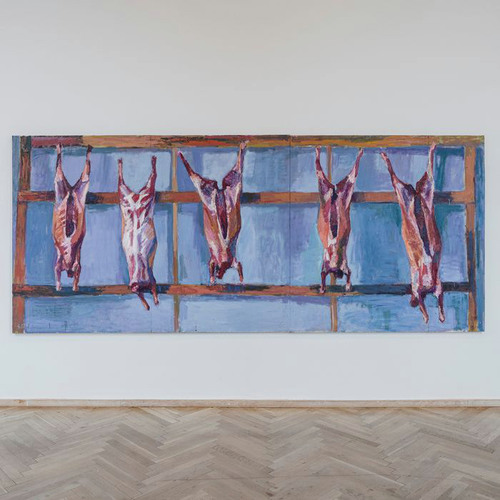Gerhard Nordström (1925-2019)
Hängande kroppar, u.å.
Olja på masonit
Förvärvad till Ystads konstmuseums samling 2021

Med skarp skärpa fångade Gerhard Nordström i sitt måleri ofta det som vi helst vill undvika att se på. Den storskaliga målningen Hängande kroppar föreställer upphängda styckade lamm på rad. Målningen lyfter både ett djurrättsperspektiv och vår förmåga att objektifiera och varufiera liv. Ett motiv som bland annat blinkar till Rembrandts Slaktad oxe från 1655. Den tyska filosofen Theodor Adorno menade att då människan porträtterar naturen genom konst är det egentligen ett sätt att behandla den undantryckta naturen inom oss. Agnus Dei, latin för ”guds lamm”, är en urkristen symbol för Kristus och hans ställföreträdande offerdöd på korset, likt ett offerlamm. I den omfattande sviten Banco di Santo Spirito gjorde Nordström upp med den katolska kyrkans makt- och pengamissbruk.
Nordströms konstnärskap präglades av en stark politisk övertygelse. Mest känd är han för antikrigssviten Sommaren 1970 - utflykt i det gröna, en skarp kommentar till Vietnamkriget och massakern i Song My där han kombinerade det skånska landskapet med de ohyggliga bilderna från massakern. Exempelvis med Sommargrönska från 1972 där köttslamsor från offer i Vietnamkriget hänger på trädens grenar.
Gerhard Nordström föddes 1925 i ett prästhem och växte upp i Sjörup utanför Ystad och Gessie söder om Malmö. Han utbildade sig på Skånska målarskolan i Malmö och vid Kungliga Konstakademien i Stockholm på 1940-talet. Nordström hade sin första separatutställning i Malmö 1950. Under 1960- till 1980-talen var han lärare på Konstskolan Forum i Malmö. 1986 flyttade Gerhard Nordström till Ystad där han avled 2019.
ENGLISH VERSION
Gerhard Nordström (1925–2019)
Hanging Bodies, undated
Oil on masonite
Acquired for Ystad Art Museum’s collection in 2021
With a sharp focus, Gerhard Nordström often captured in his paintings that which we would really rather avoid looking at. The large-format work Hanging Bodies features slaughtered lambs hung up in a row. The painting illuminates both an animal rights perspective and our willingness to objectify and commoditise living beings. The motif is a nod to previous works such as Rembrandt’s Slaughtered Ox from 1655. The German philosopher Theodor Adorno believed that when man portrays nature through art, it is actually a way of dealing with the suppressed nature within us. Agnus Dei, Latin for “the Lamb of God”, is an early Christian symbol of Christ and his surrogate sacrifice on the cross like a sacrificial lamb. In the extensive suite Banco di Santo Spirito, Nordström contended with the Catholic Church’s misuse of power and money.
Nordström’s work was marked by intense political convictions. He is best known for the anti-war suite The Summer of 1970: A Picnic in the Grass, a cutting comment on the Vietnam War and the massacre in Song My in which he combines the Scanian landscape with horrific images from the massacre. Another example is Summer Green from 1972, in which scraps of flesh from victims of the Vietnam War hang from the branches of trees.
Gerhard Nordström was born in 1925 in a pastor’s home and grew up outside of Ystad in Sjörup and in Gessie, south of Malmö. He studied art at the Scanian School of Painting in Malmö and at the Royal Swedish Academy of Fine Arts in Stockholm in the 1940s. Nordström had his first solo show in Malmö in 1950. From the 1960s through the 80s, he taught at the Forum Art School in Malmö. In 1986 he moved Ystad, where he lived until his death in 2019.
Text: Julia Björnberg
Foto/Photo: Anders Sune Berg